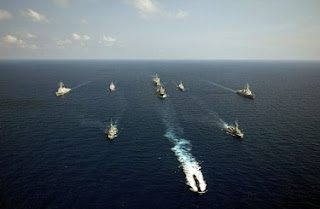A Chinese submersible conducted the country's deepest manned dive Tuesday in the latest technical milestone for China, which theoretically puts most of the ocean floor's vast resources within its reach.
The Jiaolong undersea craft -- named after a mythical sea dragon -- reached 5,057 metres (16,591 feet) below sea level in a test dive in international waters of the northeastern Pacific, the official Xinhua news agency said.
Though less than half as deep as a record 1960 dive by the US Navy, the achievement highlights a Chinese push to catch up with advanced nations in space, sea, and polar exploration, which has revealed fast-growing technical capabilities.
This campaign has been exemplified by a space programme that in 2003 made China just the third nation to conduct manned space flight.
The Jiaolong -- designed to reach a maximum depth of 7,000 metres -- had carried three people to 4,027 metres below sea level in a test on Thursday.
It conducted the test dive to break the 5,000-metre mark early Tuesday morning, again with three aboard, Xinhua said, citing the State Oceanic Administration (SOA).
Afterward, the submersible's crew appeared on the deck of the mission's main ship and held up a Chinese flag, in images broadcast on state television.
The test's success indicated that the submersible was capable of reaching more than 70 percent of the planet's seabed, the SOA said, according to Xinhua.
China has pushed hard in recent years to obtain oil, minerals and other natural resources needed to fuel its growth, and has said its submersible programme is aimed at scientific research and the peaceful exploration and use of natural resources.
Scientists say the ocean's floors contain rich deposits of a range of potentially valuable minerals, but the extreme depths pose technical difficulties in harvesting them on a wide scale.
But it may not take China long to begin reaching some of these riches, Jian Zhimin, director of the State Key Laboratory of Marine Geology at Shanghai's Tongji University, told AFP.
"I don't think it will be a very long time before China can perform deep-sea ocean-floor mining," he said, noting that many of the most valuable oceanic mineral resources are located around the Jiaolong's maximum designed depth of 7,000m.
The SOA said the submersible would attempt a 7,000-metre dive in 2012, Xinhua reported.
But China's appetite for resources, rapid military expansion and increasing assertiveness on sea territorial claims have caused concern.
During a Jiaolong dive to the bottom of the disputed South China Sea last year, it planted a Chinese flag in the seabed in what some saw as a provocative act.
The South China Sea, which is believed to be rich in oil and gas, is claimed in whole or in part by China and several other nations.
Some concerns also have been raised that deep-sea vessels could have military-related applications such as tapping into or severing communications cables.
Xinhua quoted the submersible's chief designer Xu Qinan as saying its "state-of-the-art" digital underwater communications systems and undersea mobility systems allowed it to "move back and forth easily under the sea".
Although many of the craft's components were produced in China, some had to be imported from abroad, such as the underwater high-definition video-shooting and transmission equipment, Xu told Xinhua.
The US Navy reached the bottom of the Mariana Trench -- the deepest point in the world's oceans at 11,000 metres -- in 1960.



0 comments:
Post a Comment